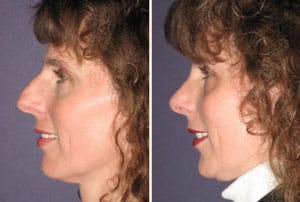Rhinoplasty is a surgical procedure in which deformities of the nose are corrected by removing, rearranging or reshaping bone and cartilage. Appropriate goals for surgery include the following:
- Balance the size of the nose with the other facial features
- Modify the width of the nose at the bridge (dorsum)
- Improve the nasal profile, including removing humps or depressions
- Contour a nasal tip that is too large, “boxy,” drooping or upturned
- Change the angle between the nose and the mouth
- Narrow and reshape the nostrils
- Correct asymmetry or deviation
- Improve breathing through the nose
- Dissatisfaction with previous nose surgery

- Dr. Wigod will discuss with you in great detail your desired changes. He will then examine your nose completely, including your internal nos,e to detect any breathing problems. Before proceeding to surgery, you and Dr. Wigod will develop and agree on a plan best suited to meet your expectations.
- The nasal skin is elevated from the underlying skeleton of bone and cartilage by making an incision under the tip and continuing it along the edge of the nostrils. The bone and cartilage are then reshaped and the skin re-draped over the surface. The nose is then carefully closed, and splinted.
- Patients who have a deviated septum which contributes to breathing difficulty or who require cartilage grafts will need a septoplasty. For nose problems involving only a dorsal hump with limited tip surgery, the rhinoplasty may occasionally be performed by making incisions inside the nose only. Rhinoplasty may be combined with chin augmentation to balance the nose with a small chin improve the overall profile.
- The plastic splint on your nose should remain undisturbed and will be removed one week post op. Keep the splint dry until removal. You may also have a splint inside your nostrils which will also be removed at one week. You may have some oozing which is not unusual. Your skin sutures will be removed one week post op.
- You may use cold packs periodically. Sleep with your head elevated for about 1 week to minimize the swelling. Bruising may occur, but usually resolves in one to two weeks. You may begin walking immediately, but avoid sweating for 2 weeks post op. Eat soft foods for the first week post op. If you have problems breathing, an antihistamine may help. You will not see your final result until at least 6 months to a year post op.
- The chin is an often overlooked aesthetic unit of the face. Enlarging a small or weak chin to balance the nose and rest of the face may make tremendous difference in your profile. A proportionate chin may make the nose look smaller, distribute flabby neck skin (as part of a neck lift), or give a more masculine look for men. Placing a chin implant can accomplish all of these goals in a durable, cost-effective, and minimally invasive way.
To schedule a consultation or for more Nose Surgery – Rhinoplasty information, please visit our contact page or call our office at 208.377.9515.


